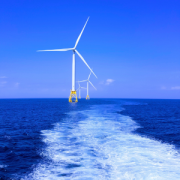The European offshore wind farm sector is expanding rapidly, in part due to new technology. There are two main types of marine wind farms: fixed and floating. Fixed structures have been in use for a while and have been widely deployed in areas such as the North Sea. Their infrastructure and footprint prevent them from being installed in deep or complex seabed locations.
Using new technology, wind turbines can be installed on floating platforms anchored to the seabed with catenaries, chains, steel cables, and flexible anchors. This opens the door to placing wind farms farther offshore in areas with higher wind potential, making them more efficient. The companies promoting these structures say they have a lower environmental impact than fixed structures (this has yet to be proven) and are easier to manufacture and install.
Another reason for European offshore wind farm expansion is the EU‘s goal of becoming climate neutral by 2050. The EU estimates that 30% of its energy demand will be supplied by offshore wind by 2050, increasing offshore wind capacity from a current amount of 14.6 gigawatts to 300 gigawatts. This would mean multiplying the marine space allocated to wind energy by 15. Experts at BloombergNEF predict that one in every nine new offshore wind turbines could be placed on a floating foundation by the mid-2030s.
Directive (EU) 2018/2001, on the promotion of the use of energy from renewable sources, has placed considerable pressure on member states. As a result, the North Sea is becoming an energy powerhouse as nearby countries seek to meet their renewable energy targets. Offshore wind farm development in the Mediterranean is still in its infancy, but that situation is changing quickly.
Overall Impact
The impact on the fishing industry, ocean organisms, physical and chemical oceanography, and coastal communities from current and planned European offshore wind farms has just begun to be studied but is expected to be significant. Environmental impacts can occur in any of five wind-energy development phases: preconstruction, construction, operation (including maintenance), repowering, and decommissioning.
From available studies, we can conclude that: (1) impacts on ecosystems and biodiversity will not be negligible, (2) the risks posed to marine ecosystems are diverse, and (3) assessment of potential project impacts must be done on a case-by-case basis, at least until a more substantial body of research comes out.
To address possible conflicts between offshore wind farm development and biodiversity protection, the EU in 2014 launched the Maritime Spatial Planning Directive (2014/89/EU). It placed a legal requirement on member states to develop and implement maritime spatial plans (MSPs) by 2021 at the latest.
However, the EU’s 2018 climate-neutral directive caused many member states to accelerate their renewable energy plans, including building offshore wind farms. This caused some disconnects. First, offshore wind farm guidance documents are still weak, especially for floating structures. Second, MSPs must also now incorporate a key recommendation from the UN Conventions on Climate Change and Biological Diversity, which states that solutions designed to address the climate issue should not make another biodiversity-related issue worse. This is the purpose of the EU’s Do No Significant Harm (DNSH) principle: solutions to one crisis cannot worsen others.
Thus, developing comprehensive MSPs for large-scale offshore wind farms has become quite complex. At a minimum, they require:
-
Assessing how existing plans balance energy requirements with other spatial interests, support coexistence, and manage related conflicts
-
Taking new planning challenges resulting from large transnational scenarios into consideration
-
Identifying requirements for transboundary planning and cooperation at the sea-basin scale in a context of ecosystem management, cumulative effects, energy security, and transnational infrastructure and policy development
-
Assessing in the best way possible offshore energy’s relation to biodiversity protection, as set out by the International Council for the Exploration of the Sea’s Working Group for Marine Planning and Coastal Zone Management
[For more from the author on this topic, see: “What Floating Offshore Wind Farms Tell Us About Biodiversity Realities.”]



